ARCHIVE – BC/NATIONAL [Sept & Oct 2017]
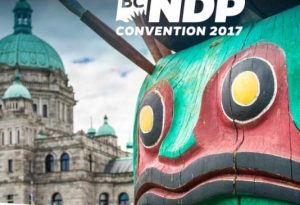 Tuesday, October 31. BC Premier John Horgan wrapped up his weekly news conference at the legislature today with “Happy Halloween everybody” after he had touched on various important matters that media queried him on.
Tuesday, October 31. BC Premier John Horgan wrapped up his weekly news conference at the legislature today with “Happy Halloween everybody” after he had touched on various important matters that media queried him on.
Regarding the BC NDP convention coming up this weekend November 3 to 5 at the Victoria Convention Centre, he said that delegates will be discussing a range of policies and initiatives, with debate on each. “People are passionate about issues on the convention floor,” said Horgan. He identified contentious issues as things people are discussing across BC in every community including “the transforming economy, and the carbon constrained economy. Attending to matters of climate change is “now mandated by the federal government” along with many other countries, “to change the way we’re doing business”. On that Horgan said: “I want to lead a government that’s enabling that change in a positive way.”
Premier Horgan says his government will “take every step to protect rural representation” during the process of riding redistribution. In his 12 years in the legislature he says he’s seen in the three redistributions that rural representation is being lost through a deviation of seat sizes. And with a tip of the hat to proportional representation, Horgan says he will “not shy away from changing a system that gives 100% power to 50% of the voters.”

The matter of BC Hydro billing rates came up. The BC NDP government hopes to be “protecting rate payers from rate shock,” Horgan said, noting that hydro rates under the previous government went up “far faster than rate of inflation and far faster than in other jurisdictions”. The BC Liberal government set a five-year rate increase of 28.5% in motion in 2014 that has burdened families and households with a significant increase to the cost of living.
On provincial budget: “We have a team working now through the Minister of Finance, to get to some solution on deferred debt. It’s just not sustainable.” The previous BC Liberal government used BC Hydro rates “as a cash cow … borrowing money and deferring debt to make the budget look balance,” Horgan explained. His government will try to “reduce the long term costs on rate payers”. “(Former Energy Minister) Bill Bennett said it was under control, it’s far from under control,” said Premier John Horgan.
The opioid problem is across BC. “It’s not acceptable to the public and not to me,” said Horgan. “All British Columbians want this to get this wrestled to the ground.” He says the federal government has given the “right language, but not sufficient resources it seems to me”. A formerly strong and high profile Minister of Health Jane Philpott in August was moved to another file, with Horgan saying it’s taking time for the new Minister of Health Ginette Petitpas Taylor to bring things up to speed. In BC, Horgan says there are more safe injection sites and replacement programs in place. “I’m personally disappointed at the numbers of deaths going up right across the province.” Horgan says later this week he expects to be talking with the federal government on other issues and that whenever he gets the chance he’s ‘pushing’ for more attention to the opioid crisis. “It’s not moving fast enough,” he said, but feels that his “positive working relationships with Ministers here in BC and with the Prime Minister” will help.
 Sunday, October 29 ~ BC. There’s still time to have your say on how BC should regulate the use of non-medical cannabis when the federal government legalizes marijuana in July 2018.
Sunday, October 29 ~ BC. There’s still time to have your say on how BC should regulate the use of non-medical cannabis when the federal government legalizes marijuana in July 2018.
The BC government says its goal is to build a provincial regulatory framework for non-medical cannabis that “prioritizes the protection of young people, health and safety, locking criminals out of the industry, and keeping roads safe”.
Specifically, to help ensure that BC’s provincial cannabis regulatory system reflects the needs and values of British Columbians, government is seeking feedback on the following issues:
- minimum age;
- personal possession limits;
- public consumption;
- drug-impaired driving;
- personal cultivation; and
- distribution and retail models.
It’s an opportunity to “become a part of history and help ensure the framework best represents their interests and priorities”, it was stated in a release from the Ministry of Public Safety and Solicitor General on October 25.
The deadline is 4 pm on Wednesday November 1 to comment on issues such as minimum age, personal possession limits, consumption in public, drug-impaired driving, personal cultivation, distribution and retail models. See: http://engage.gov.bc.ca/BCcannabisregulation/
Since September 25, over 30,000 British Columbians have completed the survey and provided feedback.
 Wednesday, October 25, 2017 ~ BC. Local governments throughout BC have until November 1, 2017 to provide feedback on the provincial discussion paper, Cannabis Legalization and Regulation in British Columbia.
Wednesday, October 25, 2017 ~ BC. Local governments throughout BC have until November 1, 2017 to provide feedback on the provincial discussion paper, Cannabis Legalization and Regulation in British Columbia.
The Province will draw upon feedback obtained through the engagement process as it considers key policy decisions that will form the foundation of its legalized cannabis framework, it was stated today by the Union of BC Municipalities (UBCM).
UBCM encourages all local governments to provide submissions to ensure that feedback provided to Province represents the diversity of our membership. Local government responses to the discussion paper will be considered as a separate cohort among the feedback provided.
Many people across Canada already use cannabis products for medicinal reasons. Recreational users often incur criminal records for simple possession, something that will likely fade away after the federal government brings in their new laws and regulations in July 2018.
Considered by pretty much all stakeholders to be a positive aspect of the upcoming legislation is to keep marijuana products out of the hands of youth (for health and safety reasons), and to control or eliminate the current black-market and criminal element of marijuana sales. The federal government will gain tax revenues under the new legislation. Provincial and municipal governments also stand to gain financially under the new laws and regulations.
For many, a major concern remains about road safety related to cannabis use. While for alcohol consumption the roadside blood-alcohol level testing has become mainstream, the ways and means for testing one’s state of clarity while operating a motor vehicle under the influence of marijuana remains to be fully determined.
Presently on the west shore of Vancouver Island:
>> In Sooke, a few marijuana-product outlets have already been operating in the town centre area for almost two years. About that… Sooke Council has had discussions but is essentially waiting for federal legislation to come into effect. Today Sooke Mayor Maja Tait (who sits on the UBCM executive) told West Shore Voice: “We received a staff report on Monday and will send a response summarizing the highlighted concerns within. These regulations and the Provincial request pertain to the Federal Government’s legalization of non-medical cannabis, that was the focus of our Agenda.”
>> In Colwood, the City of Colwood Council has had discussions about cannabis legalization and regulation, as well as participating in discussions at the Association of Vancouver Island Coastal Communities and Union of BC Municipalities conferences. “The City will adhere to the current Colwood Land Use Bylaw and Business Bylaw until such time as the Federal and Provincial governments provide direction regarding legalization,” said Colwood’s communications manager Sandra Russell today. The Colwood Land Use and Business Bylaws currently prohibits marijuana dispensaries other than a licensed pharmacy or premises licensed under the “Marijuana for Medical Purposes Regulations”.
>> In Langford, a few marijuana product outlets that have opened have been quickly shut down through bylaw-related mechanisms. No statement on this topic was provided from the City of Langford today.
> Link to the Cannabis Legalization and Regulation in BC discussion paper: http://engage.gov.bc.ca/app/uploads/sites/217/2017/09/Cannabis-Legalization-and-Regulation-in-BC_Discussion-Paper.pdf

Wednesday, October 25 ~ BC. Funding from the BC Government is available to manage urban deer, it was announced today by the Ministry of Forests, Lands, Natural Resource Operations and Rural Development.
Up to $100,000 will be provided to local governments and First Nations communities (that are involved in urban deer activities or research into population control methods) to help fund urban deer management projects under the 2017-18 Provincial Urban Deer Cost-share Program. Applications due on or before November 17, 2017, info: 2017-18 Urban Deer Cost-share Program Application Guide
Eligible proposals will be evaluated by members of the Provincial Urban Deer Advisory Committee which includes reps from the Province, local governments, the Union of BC Municipalities and the BC Society for the Prevention of Cruelty to Animals. Successful proponents will be advised in December.
Projects that address human-deer conflict in areas where traditional deer management techniques are not appropriate will be given priority. Matching funds are required from any local government or First Nation that applies.
There are about 135,000 mule deer, 128,000 black-tail deer and more than 100,000 white-tail deer in BC. Deer are managed in BC by the BC Government which authorizes municipalities to undertake urban deer management actions. Provincial support includes technical advice, regulatory authority, necessary permits, specialized equipment and other management tools.

Tuesday, October 24 ~ BC. BC’s three nursing colleges will be able to form one organization, providing a single set of bylaws for consistent structures, processes and an improved patient experience, as a result of amendments introduced today by Health Minister Adrian Dix.
Amendments to the Health Professions Act set the stage for the provincial nursing colleges to amalgamate, providing greater consistency for the profession and one point of contact for patients and partners.
The amendments allow for any of BC’s health profession colleges to amalgamate. This was prompted by a request from the nursing colleges to help streamline regulation.
In recent years, the College of Registered Psychiatric Nurses of BC (CRPNBC), College of Licensed Practical Nurses of BC (CLPNBC) and College of Registered Nurses of BC (CRNBC) have been working together on nursing regulations and standards, and have become more aligned in their efforts. This legislation lets them take the next step and amalgamate.

The Health Professions Act states that it is the duty of the college to protect and serve the public at all times. With this in mind, the legislation will also allow for the appointment of an administrator for a health profession college. This is a safeguard in the event that a college board is seen to be acting to protect the interest of the health profession instead of the patient.
Patient safety will also be further supported as amendments will ensure that infection control breaches can be reported to public health officials in a timely manner. For example, if poor sterilizing practices are observed, the amendments will ensure they can be reported immediately. Currently, while any breach can be reported, it must first go through college investigation processes instead of directly to public health officials in a timely manner.
There are approximately 55,000 nurses licensed in BC. The CRPNBC regulates registered psychiatric nurses, the CLPNBC regulates licensed practical nurses and the CRNBC regulates registered nurses and nurse practitioners.
A single nursing regulator also exists in Ontario, the United Kingdom and Australia, with Nova Scotia exploring a similar approach.
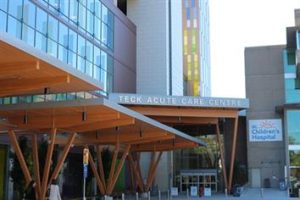
Friday, October 20 ~ VANCOUVER. Newborns, children and expectant mothers from all around the province will be cared for in the new Teck Acute Care Centre, located on the campus of BC Children’s Hospital and BC Women’s Hospital, officially opened today by BC Premier John Horgan, health care workers and patients.
“When children need hospital care, they should be in a place that feels like home, where they can play, exercise their imagination, and be surrounded by family to help them heal,” said Premier Horgan. “This new centre means better care for thousands of patients and their families from every part of B.C. who access the building.”
Each area of the building is modelled after a different part of BC with the hope that children, women and their families can feel at home. The room where medical procedures, such as bone marrow extractions, are performed will have a ceiling lit with as many as 100 twinkling LED lights. These lights will recreate the night sky over Vancouver and show major constellations.
“The new acute-care centre will provide improved comfort and privacy for families in their time of need,” said Health Minister Adrian Dix. “A perfect example of this is the centre’s neonatal intensive care unit, which is designed to keep new moms together with their babies in the same room, helping to promote bonding and reduce stress. This model of care means less separation for families and is a key way to help ensure these vulnerable babies get the very best start in life.”
The Teck Acute Care Centre — which opens to patients on October 29, 2017 — will serve the entire province. It features a larger children’s emergency department, additional patient beds and an expanded neonatal intensive care unit – all equipped with single-patient rooms. Patients and families will have access to laundry facilities, family lounges and dining rooms, play areas, resource rooms, and storage space. Natural light and green spaces will add to the health and well-being of patients and staff.
The eight-floor, 59,400 sq m (640,000 sq ft) centre has 231 private patient rooms, medical/surgical in-patient units, medical imaging, procedural suites, a hematology/oncology/ bone marrow transplant department, a pediatric intensive care unit, and a high-risk labour and delivery suite.
Also opening is the BC Women’s Urgent Care Centre, which will provide care for women throughout their pregnancies and up to six weeks post-birth. The urgent-care centre, which is expected to see approximately 13,000 patients a year, includes 10 larger, single-patient rooms that will provide a quieter space with increased privacy for new moms and families.
The Teck Acute Care Centre opening marks the completion of the second phase of the BC Children’s and BC Women’s Redevelopment Project, a three-phase, multi-year initiative at BC Children’s Hospital and BC Women’s Hospital and Health Centre.
“We want to recognize the Provincial Health Services Authority (PHSA) and the BC government for having built an extraordinary facility that will transform child health care in BC,” said Don Lindsay, chair of the BC Children’s Hospital Foundation, and president and CEO of Teck. “We also want to acknowledge the generous support from over 80,000 British Columbians who supported the Campaign for BC Children. Teck and its employees throughout BC are incredibly proud to have played a role in making this new hospital a reality.”
“I am proud to say phase two of this ambitious project was delivered on time and on budget,” said Tim Manning, Provincial Health Services Authority board chair. “Today we applaud the countless hours of work by our partners, our patients and families, and our health-care teams, along with those who generously donated to the project.”
Susan Wannamaker, president of BC Children’s and Women’s Health, praised the efforts of staff and physicians at both hospitals. “They have great enthusiasm for the new space, technology and equipment that will continue to support the exceptional care they provide. It showed in their willingness to embrace the training and preparations in anticipation of patient move day.”
“The new facility will help the hospitals attract and retain the very top health professionals and clinical staff,” Wannamaker added.
Phase three of the redevelopment project includes relocating Sunny Hill Health Centre for Children to the Oak Street Campus and the addition of 10 single-room maternity-care spaces at BC Women’s Hospital. Construction is scheduled to begin in 2018. The total cost of the three-phase redevelopment project is estimated at $676 million.
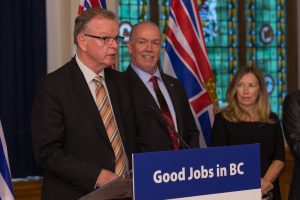
“Small businesses are the economic engines of BC’s communities and create good jobs for people throughout the province,” said Premier Horgan. “We’re working hard to make sure that small businesses and manufacturers have the support they need. That’s why we’re reducing the small business tax rate to 2% from 2.5% and establishing a Small Business Task Force to help strengthen and grow the sector in BC”.
The Small Business Profile 2017 report shows that employment in BC’s small-business sector grew faster in 2016 than at any time in the past decade, with more than one million people employed in small businesses last year. However, that growth statistic is not surprising, in that most small businesses were severely impacted by the long drawn-out recession and recovery period after the crash in 2008.
The BC government says that small businesses produced more than one-third of provincial GDP in 2016 and $15.8 billion in exports in 2015, an increase of nearly $3 billion over the previous year.
Long the entrepreneurial energy in BC, the latest numbers show that BC leads the country in growth in the number of new small businesses and has the highest number of small businesses per capita across Canada, with small business making up 98% of all businesses in the province.
“There are significant growth opportunities ahead in advanced manufacturing, while the growth of small and medium-sized businesses can be fast-tracked by relying more on the use of technology,” said Jobs, Trade and Technology Minister Bruce Ralston. “Small businesses and manufacturers help create well-paying jobs for British Columbians throughout the province, and are major contributors to the provincial economy.”
As part of Small Business Week, the Province has partnered with Small Business BC to offer free professional seminars, webinars and ‘Ask the Expert’ services for small businesses during this time. Entrepreneurs and organizations representing small businesses and manufacturers will be marking both Small Business Week and Manufacturing Week with events throughout the province.
“We at Small Business BC are thrilled to partner with the Government of BC for Small Business Week to provide our high-quality training and expert advice to small businesses, free of charge,” said Sandra Miles, chair of Small Business BC. “By making it possible to share these valuable tools for free, the Province is giving small business owners the opportunity to learn, grow, and succeed in their endeavours.”
As many of BC’s manufacturers are small businesses, declaring Manufacturing Week and Small Business Week together provides an opportunity for stakeholders to take advantage of events supporting both sectors.
“Manufacturing is a critical part of BC’s economy, contributing 7.2% of GDP,” said Andrew Wynn-Williams, vice-president of Canadian Manufacturers and Exporters BC Division. “We also produce some fascinating products in BC and Manufacturing Week gives us an opportunity to profile for the public the nature of the industry and some of the cool things we make.” Manufacturing Week in BC is part of a broader national Manufacturing Month initiative led by Canadian Manufacturers and Exporters (CME) to profile manufacturing across Canada, and is intended to boost the public profile of the manufacturing sector’s contributions to the economy.
Small businesses make up 98% of all businesses in BC, generating 34% of provincial GDP in 2016, above the Canadian average of 31%. Small businesses were the source of 32% of all wages paid to workers in BC last year, the highest share of all provinces and above the Canadian average of less than 27%.
Employment in BC’s small business sector climbed 3.1% in 2016, the highest rate of growth in over a decade. Approximately 1,056,300 British Columbians worked in small businesses in 2016, accounting for 54% of total private-sector employment, above the national average of 49%. Small businesses in BC shipped $15.8 billion worth of goods to international destinations in 2015, making up 42% of all provincial exports. Small businesses comprise almost 96% of employers in the high-technology sector.
British Columbia had the highest number of small businesses per capita in Canada in 2016, with 83.4 small businesses per 1,000 people. The national average was 69.9.
When it comes to the manufacturing sector, that’s a significant economic driver for the province, generating $16 billion for BC’s economy and supporting approximately 170,000 jobs. Manufacturing wages are 15.5% higher than the overall average for all industries, according to CME. There are more than 7,200 manufacturing companies in British Columbia. The manufacturing sector’s focus on export markets and innovation supports job growth across every manufacturing sub-sector in the province, including aerospace, marine, pharmaceuticals, agriculture and apparel. Manufactured goods account for 58% of BC’s total goods exports to international destinations. Manufacturing Week is held in conjunction with CME’s Manufacturing Month and highlights the role BC’s manufacturers play in creating well-paying jobs throughout the province.
Small Business Profile 2017 | Small business in BC | Manufacturing in BC | seminars, webinars and services by Small Business BC for Small Business Week

Tuesday, October 17 ~ NATIONAL. Small businesses are the getting the break they were promised! Announced yesterday at the start of Small Business Week across Canada, the federal government announced that the small business tax rate in Canada will get back to 9% by 2019, as promised by Trudeau during the 2015 federal election campaign. Presently it’s 10.5% and it will go to 10% at January 1, 2018 before it gets to 9% the year after that.
Naturally this is good news for small business. No one can argue or resist a reduction in tax rate. As part of the federal announcement was the claim that it could save up to $7,500 per year for small businesses once the full rate reduction is in place. While that helps, it’s not an enormous sum in light of the continued struggle of small business in an economy where big players largely rule the roost.
The Canadian Federation of Independent Business (CFIB) put out a statement welcoming the federal government’s decision to reinstate its promise to reduce the small business corporate tax rate to 9%.
“I am pleased to see the government make good on its commitment to lower the small business rate by 2019,” said CFIB president Dan Kelly. “This decision will pump hundreds of millions of dollars back into the small business community, helping them create more jobs and grow the economy.”
“Still, the changes to rules allowing business owners to share income with their family members remain a concern for middle-income businesses.”
CFIB is pleased the government has provided some clarity on the new rules around income-sprinkling – particularly, they will no longer be moving forward with measures that limit access to the lifetime capital gains exemption. However, CFIB remains concerned that the changes may not reflect the many formal and informal ways family members participate in the business.
“We are worried that the income sprinkling changes will keep the benefits of business ownership out of the hands of many spouses who participate in more informal ways in the business – particularly women,” said Kelly.
CFIB is anxiously awaiting details on passive income rules and the treatment of capital gains related to business succession. “We will wait for details and analysis on all the changes before passing judgment on the entire package,” added Kelly.
“As Small Business Week begins, I am heartened by the outpouring of support for small businesses over the past three months. CFIB will be providing direct feedback to government on the full package of changes in the weeks ahead.”
For Small Business Week check out www.shopsmallbiz.ca and on Twitter #SmallBizSaturday
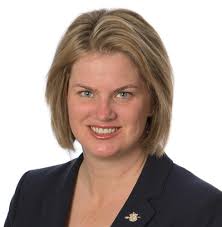
Friday, October 13 ~ BC. “ShakeOutBC is a great opportunity to break from our routines, practice our earthquake response and take a moment to reflect on our level of preparedness,” says Jennifer Rice, Parliamentary Secretary for Emergency Preparedness.
“We each have a duty to prepare our family and our community for emergencies.” We encourages people to participate in the Drop, Cover and Hold On drill on Oct 19.
BC sits in one of the world’s most seismically active regions, with more than 3,000 earthquakes recorded every year. Most are too small to be felt, but the risk of one being big enough to cause damage is real.
The best immediate response in an earthquake is to Drop, Cover and Hold On. Thousands of people practice this life-saving technique every year as part of the Great BC ShakeOut which is Canada’s largest earthquake drill.
Families, schools, businesses or organizations can register for ShakeOutBC at www.shakeoutbc.ca/register
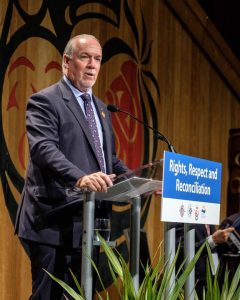 Tuesday, October 10 ~ BC. BC Premier John Horgan is visiting Alert Bay today following an invitation from Chief Bob Chamberlin of the Kwikwasutinuxw Haxwa’mis First Nation. Premier Horgan will hear from local First Nations leaders, elders and community members on a range of topics and particularly on the challenging issue of Atlantic salmon aquaculture. The meeting will run from 10:15 am to 2:30 pm at the ‘Namgis Traditional Big House.
Tuesday, October 10 ~ BC. BC Premier John Horgan is visiting Alert Bay today following an invitation from Chief Bob Chamberlin of the Kwikwasutinuxw Haxwa’mis First Nation. Premier Horgan will hear from local First Nations leaders, elders and community members on a range of topics and particularly on the challenging issue of Atlantic salmon aquaculture. The meeting will run from 10:15 am to 2:30 pm at the ‘Namgis Traditional Big House.
Two Atlantic salmon fish farms in the region are currently being occupied by protestors. The industry generated $787 million in annual value in 2016 and supports about 5,000 rural and coastal jobs. B.C.’s new government is committed to implementing the recommendations of the Cohen Commission and working with Indigenous communities, the federal government and industry on the issue of Atlantic salmon aquaculture.
With Premier Horgan today in Alert Bay will be Scott Fraser, Minister of Indigenous Relations and Reconciliation as well as Agriculture Minister Lana Popham and Minister of Transportation and Infrastructure and MLA for North Island Claire Trevena.
First Nations participants include: ‘Namgis First Nation, Dzawadaenuxw First Nation, Kwikwasutinuxw Haxwa’mis First Nation, Mamalalikula First Nation, and Kuterra land-raised salmon farm.
There were similar problems with Atlantic salmon acquaculture on the west side of Vancouver Island this past summer where an enclosure lost containment, allowing for the possible cross-contamination with natural Pacific salmon as well as competition for natural food sources.

Tuesday, October 10 ~ OTTAWA. Prime Minister Justin Trudeau and Sophie Gregoire Trudeau are off to Washington today for two days, for business talks, social events and photo ops.
This visit takes place amidst a time of NAFTA negotiations, stresses with North Korea, and the political strain of the Black Lives Matter kneeling issue at professional sports events. Trudeau’s official public engagements focussing on women in business is a soft-edge diplomatic touch.
On Tuesday evening, The Trudeaus will attend the Fortune Most Powerful Women Summit and Gala. On Wednesday morning,along with Minister of Foreign Affairs Chrystia Freeland, the Trudeaus will participate in the Women One Roundtable Discussion. After that, the Prime Minister and Freeland will meet with the Committee on Ways and Means.
On Wednesday afternoon October 11, the Trudeaus will arrive at the White House and be greeted by US President Donald Trump and First Lady Melania Trump. Trudeau and Trump will meet privately around 2:05 pm, after which Trudeau is scheduled to meet with media around 3:40 pm.
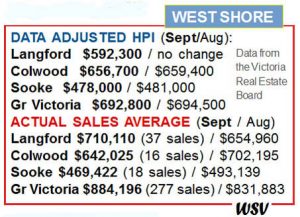 Saturday, October 7 ~ WEST SHORE. Duality in Greater Victoria real estate this fall season. Real Estate Analysis by Mary P Brooke ~ West Shore Voice News
Saturday, October 7 ~ WEST SHORE. Duality in Greater Victoria real estate this fall season. Real Estate Analysis by Mary P Brooke ~ West Shore Voice News
There’s been a stone-cold drop in activity and a significant cooling in prices in many average-price areas of the Greater Victoria real estate market in recent weeks.
But in three areas actual sales price averages jumped dramatically between August and September: Langford was up by $55,150, East Saanich was up by $42,565 and North Saanich prices skyrocketed by $152,407. Prices in high-end Oak Bay notably dropped by almost $94,000 (only post-peak stock may have been available).
In September there were 18.1% fewer properties sold than a year ago. East Saanich is normally the bell-weather of pricing trends, and Langford seems to be following suit.
The Victoria Real Estate Board says the market is “trending slowly towards more balanced conditions and overall price increases are levelling”. But their own stats tell a different story. The trend is not slow. prices are ‘acting out’, and the most stable areas (East Saanich and Langford) show distinct upward pressure.
Two Bank of Canada interest rate hikes this summer cut the legs out from under the lower end of the market, hurting entry-level buyers and sellers of modest homes.
Housing inventory rose in September 2017 (up 3.1% from August) as properties have become more difficult to sell. In the fast-growing City of Langford the actual sale price of single family homes surpassed $700,000 last month while Colwood and Sooke prices plummeted.
This article was first published in the October 6, 2017 issue of West Shore Voice News.
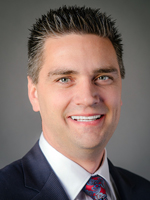
Friday, October 6 ~ BC. BC Liberal MLA Todd Stone (MLA for Kamloops-South Thompson) will be making “a special announcement regarding the future of the party and the province” on Tuesday, October 10 in Surrey. He will also do campaign-style stops in Victoria and at Thompson Rivers University in his home town of Kamloops. He is expected to announce his candidacy to run for the BC Liberal leadership.
Stone was the Minister of Transportation and Infrastructure under the Christy Clark Liberal government from June 2013, during which time his Ministry launched a 10-year plan to expand and enhance highways and roads throughout BC. He also served as Minister Responsible for Emergency Management BC and Deputy Government House Leader. He was also a member of the Priorities and Planning Committee.
Former Liberal cabinet minister Peter Fassbender says BC needs a fresh vision to keep the province on track. The first of six BC Liberal candidate debates is set for October 15 in Surrey, with party members embarking upon their process to select a new leader to replace former premier Christy Clark by early February 2018.
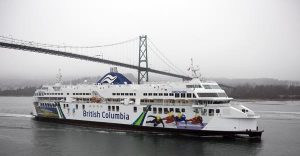
Friday, October 6 ~ COASTAL BC. This morning was the first of several 6am sailings by BC Ferries vessels between Metro Vancouver and Victoria. The additional sailing time (sailings normally start at 8 am) is part of accommodating heavier ferry traffic on the busy Thanksgiving Long Weekend.
“It was a good load from Swartz Bay to Tsawwassen this morning on the Coastal Renaissance,” said BC Ferries communications rep Deborah Marshall. There were 250 vehicles on board the Super C-Class vessel, which is about 80% of the ship’s 310-vehicle capacity.
There was also good use of the 6 am sailing from the Vancouver side over to the island. The Tsawwassen to Swartz Bay sailing on the Queen of New Westminster carried 150 vehicles which is 60% of the 250-vehicle full capacity.
There will be another set of 6 am sailings on Saturday October 7 and on Thanksgiving Monday October 9 plus Tuesday October 10.
There will also be some midnight departures on October 6 and 9 from both terminals on the Metro Vancouver-Victoria route (Tsawwassen-Swartz Bay) as part of the additional 90 sailings on BC Ferries for this long weekend.
The most popular travel times are expected to have been yesterday afternoon (October 5) and this afternoon Friday October 6, as well as tomorrow (Saturday) morning.
BC Ferries says the busiest day of the long weekend is likely to be Monday, October 9, with traffic returning to the mainland from the Departure Bay, Swartz Bay and Langdale terminals. Duke Point terminal tends to be less congested than Departure Bay, so customers returning to Vancouver from the Nanaimo area may consider travelling through the Duke Point terminal.
Parking lots at the major terminals may reach capacity at the height of the weekend, so public transit is suggested as an option for foot passengers.
Route info and sailing conditions: www.bcferries.com
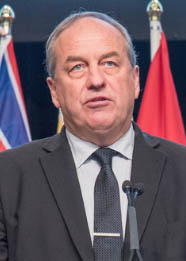
“Last week at UBCM the Premier indicated that his government’s solution to the problem of housing affordability is to simply add more supply,” Weaver said. Supply is required, but it goes deeper than that.
“Once more our government has missed the glaring problems on the demand side,” said Weaver. Weaver pointed out that when in opposition, Minister Eby (now Attorney General) was a fierce critic of the government’s failure to act, and argued that the bare trust loophole costs British Columbia hundreds of millions of dollars that could be used for affordable housing initiatives.”
Weaver is calling for the Horgan NDP government to “take action immediately to close the bare trust loophole that incentivizes speculation, discourages transparency and encourages property tax avoidance”.
Weaver is calling for bold solutions to the affordable housing crisis that is facing many communities. He is targeted the non-resident foreign buyer’s tax as something that should be extended to the entire province. The BC Greens are also calling for a ban on foreign ownership of ALR land over five acres, as a way to stem speculation and protect British Columbia’s food security.
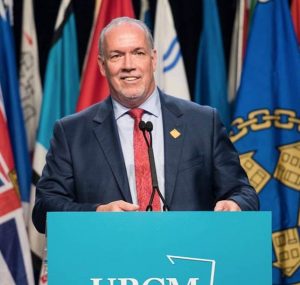
Last week at UBCM, presenters armed with data in a presentation about the housing market argued that housing prices in Victoria and Vancouver will remain consistently high due to the desirability of people wanting to live in these urban areas of the BC coastal region.
In a presentation on September 25, Josh Gordon, Assistant Professor in Public Policy at SFU said there is “too much investment in the housing market” which is increasing transaction costs. “Private housing was never meant to be an investment vehicle,” said Gordon. As he was addressing municipal officials, he added: “No action by local authorities can have any impact on pricing.” He continued that housing prices have reached “unprecedented levels” in Vancouver and Victoria, but showed with housing trends data that squeezing regular homeowners out of the market is “not a Canada-wide issue”. Professor Gordon called it a “two-track market”. He left those in room a bit overwhelmed but arguably convinced.
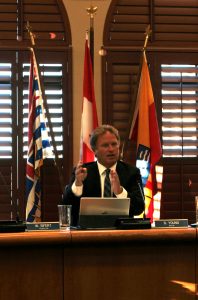
Municipalities like the City of Langford are keen to boost housing supply, having added about 500 to 600 homes (single family, townhome, condo, apartment rental and subsidized housing) per year in the past few years. Further, Langford Mayor Stew Young sees continued supply as a way to provide jobs and build the local and regional west shore economy, where businesses increasing flock to be part of the burgeoning economy there.
Sunday, October 1 ~ EDMONTON. Attack in Edmonton. A police officer and four others were taken to hospital in Edmonton on Saturday night September 30 following a violent rampage by a 30-year-old Somali immigrant man. Police say the man showed no active signs of terrorist recruitment or radicalization.
Today BC Premier John Horgan issued a statement, including: “I was shocked and saddened to learn of last night’s violent attacks against police and the people of Edmonton. British Columbians stand united with the people of Alberta – and all Canadians – against violence and hate in all its forms.”

Sunday, October 1 ~ NATIONAL. The federal NDP have a new leader. Today October 1, Jagmeet Singh won the NDP Leadership race on the first ballot with 53.8% of valid votes cast.
An Osgoode Law School graduate, Singh won with 35,266 votes. Overall turnout was 52.8 per cent of eligible NDP member voters.
Fundraising, polls and membership sign-ups suggested that Singh was on track for a strong first ballot result, though winning on the first ballot is an NDP feat only achieved in the past by Tommy Douglas and Jack Layton.
There were strong indications throughout the campaign that Singh’s support was largely being drawn from new members, though some seasoned MPs (like Randall Garrison, Esquimalt-Saanich-Sooke) were vocally supportive in recent weeks. Pre-existing members of the party opted largely for the other three leadership candidates — Charlie Angus, Niki Ashton and Guy Caron — who are sitting MPs and long-time party figures.
The NDP are obviously looking for new hope and a fresh start with a leader who brings new skills, talents and celebrity charm to the role. This will put Singh as the NDP leader up against Prime Minister Justin Trudeau (Liberal) and Andrew Scheer (Conservative) in the Fall 2019 federal election.
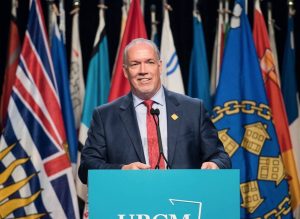
In his speech on Friday, September 29 — joking it would be rivaled as ‘the biggest speech ever’ at a UBCM convention (playing on the spoof popularity of crowd-size assertations on Saturday Night Live) — he went light on specifics about the wide range of deliverables that his NDP government still plans to roll out. Already, in the first few weeks since taking office in July 2017, Horgan and his ministers have been going down the checklist of campaign promises, including increased disability and income assistance, promising to build more housing considered ‘affordable’, and a focus on mental health and addiction.
Today he reiterated what is already in Selina Robinson’s mandate letter as Minister of Municipal Affairs and Housing, that the promised 114,000 housing units will be in market rental, non-profit, co-op, supported social housing, and owner-purchase housing. However, some specifics included an announcement about 600 modular homes in being available for the Vancouver area, with 150 in Surrey, and more in Smithers “and any other community that modular will fit with your package of solutions”. The Premier described the homes as inexpensive, quick to place, and movable. He told municipal leaders officials: “If you’ve got land and zoning, we’ve got the cans. Let’s get this going.”
And while on the surface it sounded positive, Premier Horgan did level a bit of a blow to his own home riding, where the City of Langford is bidding on bringing the new Amazon Headquarters 2 (HQ2) to south Vancouver Island. As reported in West Shore Voice last week, the Amazon project is an opportunity for some 50,000 jobs and billions of dollars in investment. In the same breath as saying “let’s bring more high tech jobs to BC,” and encouraging all communities to step up to the Amazon bid process, Horgan said the BC government will financially back only Vancouver’s bid for Amazon HQ2, to the tune of $50,000.
Horgan pitched to “work with everybody in this room” to come up with innovative ways — all levels of government working together – for “a better BC for all of us”. He itemized the need for resource jobs, as well as in high tech, tourism, agriculture and manufacturing. “Every corner of BC has something to offer the world. It starts by working together,” Horgan said.
He talked about the opioid crisis, with solutions seen as being in opening up more treatment centres, increasing anti-trafficking in law enforcement, and having already set up a new ministry of Mental Health and Addictions.
Regarding the threat to the BC softwood lumber industry, Horgan gave the crowd in Vancouver some verbal muscle, without specifics: “If the US wants to go to court… we’ve won every dispute we’ve had, and we’ll win this one as well.”
Premier Horgan said he had a bit of fun while in Vancouver by suiting up with professional firefighters of BC at the Vancouver fire operations centre, in the wake of having visited wildfire areas of the BC Interior this past summer. The worst fire season in BC’s history, this past summer saw communities devastated, people dislocated, and small businesses seriously set back. Dealing with the wildfire scenario was Horgan’s first major requirement for action after he became Premier on July 18. ~ WSV
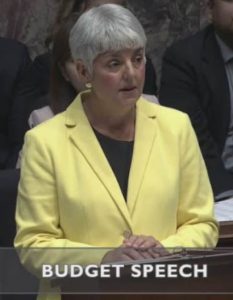
Tuesday, September 26 ~ BC. Government undertakes fiscal sustainability review
“Trust but verify” and “garbage-in garbage-out” are sayings that come to mind with this BC finance announcement about checking the quality of the information upon which earlier budget projections were based.
It’s a fiscal sustainability review and it makes good sense for a new government to do this.
Indeed, the BC Ministry of Finance released a statement today saying that the review will “help inform the development of Budget 2018 and the next three-year fiscal plan”. It will include a review of financial information submitted to the Province by specific Crown corporations and the broader schools, universities, colleges and health (SUCH) sector.
Independent consultants have been contracted to help the provincial government assess the quality of financial information built into the baseline assumptions in the budget development process. The goal of the review is to assess the information, evaluate risks and identify options that will assist the Province with developing, monitoring and managing to its overall fiscal plan targets.
The review covers selected significant Crown corporations including: BC Lottery Corporation | BC Hydro | Insurance Corporation of British Columbia | Liquor Distribution Branch | BC Housing Management Commission (including Provincial Rental Housing Corporation).
In addition, the review will include a high-level assessment of the information provided by SUCH (schools, universities, colleges and health) sector entities through the ministries responsible for their fiscal planning, monitoring and management.
The review will be completed in advance of Budget 2018 in order for information to be incorporated and reflected in Budget 2018.
“This review will help inform the decisions we make as a government as we work to build Budget 2018,” said Minister of Finance Carole James, in a news release September 26. “My expectation is that the review will give government a better picture of the risks, finances and fiscal forecasts of significant Crown corporations and SUCH sector entities, so that we foster long-term fiscal sustainability in planning and developing our budgets and decisions.”
Minister James said that “every additional dollar that is carefully managed can be used to help make life more affordable for people, invest in services and build a strong, sustainable economy.”
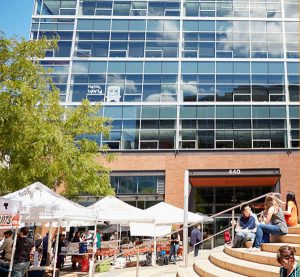
Saturday, September 23 ~ LANGFORD. If you don’t try, you’ll never know. The City of Langford with its go-after-it can-do attitude and team approach has assembled a bid to attract Amazon to the west shore of Vancouver Island.
They’re responding to a tender put out by Amazon on September 7 for a location at which the online retailer can set up their second North American headquarters (HQ2 for short). HQ2 would be a full equal to the company’s main headquarters in Seattle, WA said Jeff Bezos, Amazon founder and CEO, in a statement earlier this month.
After their October 19 deadline, Amazon will be seeing Langford’s pitch in front of them along with at least 50 bids from major cities across North America (likely including, in Canada, these — Ottawa, Calgary, London, Edmonton, Toronto).
If nothing else, it’s good international exposure for Langford, but Langford Mayor Stew Young and senior staff are optimistic.
“We have great transportation routes, an international airport and seaplanes,” said Mayor Young this week. Of course, the $5 billion that the online retailer would spend to build HQ2 would be the first great part of Amazon putting down roots in Langford.
Amazon HQ2 would eventually employ up to 50,000 people full time over a 10-year period. In addition to Amazon’s direct hiring and investment, construction and ongoing operation of Amazon HQ2 would create tens of thousands of additional jobs and tens of billions of dollars in additional investment in the surrounding community.

As well, being in Canada would offer the US company a cheaper dollar as well as trade agreements into Europe and Asia that are separate from NAFTA, which is probably why the Request for Proposal (RFP) was not limited to American cities.
Stew Young was approached by the business community to give this bid a shot, even though the Amazon RFP states the need for a base population of 1 million people. Greater Victoria is about 370,000 people, but the extended region could be seen to include adjacent regions of Vancouver Island, and by ferry-extension, the lower mainland.
In the last few years Langford’s population has surpassed 40,000 and the development community keeps on building houses, townhomes, condos and rental apartments to help Langford try and keep up to housing demand.
Amazon’s headquarters in Seattle is comprised of 33 buildings, in total about 8.1 million sqft. That includes 24 restaurants/cafes and eight other services. Their capital investment in buildings and infrastructure was $3.7 billion. Operational expenditures are $1.4 billion (utilities/maintenance). Employee payroll is about $25.7 billion/yr. About $43 million is paid into Seattle’s transportation system. In 2016 about 233,000 hotel nights were booked by visiting Amazonians and guests.
Amazon estimates its investments in Seattle resulted in an additional $38 billion to the city’s economy (2010-2016) – every dollar invested by Amazon generated an additional 1.4 dollars for the city’s economy overall.
Naturally there is buzz in cities across North America to throw their hats into this enormous ring. Some financial critics say the magnitude of the project could overwhelm a city or region that is not prepared to handle it. On the other hand, it’s an opportunity that likely comes once in a city’s lifetime.
The closing date for the RFP is right around the corner. The entire tech industry and community of municipalities in Canada and the US are keen to see how this one plays out.
This article was first published in the Print/PDF September 22, 2017 issue of West Shore Voice News.
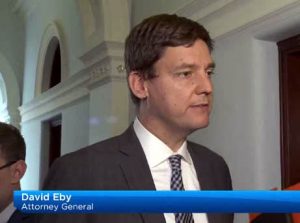 Wednesday, September 20 ~ BC. VICTORIA – The Government of British Columbia has introduced legislation to put an end to big money in politics and put people back at the heart of government decision-making. Premier John Horgan made the announcement yesterday.
Wednesday, September 20 ~ BC. VICTORIA – The Government of British Columbia has introduced legislation to put an end to big money in politics and put people back at the heart of government decision-making. Premier John Horgan made the announcement yesterday.
And while it fulfills a campaign promise toward fairness in the electoral system, there’s a catch. This fiscal year it will cost the taxpayers big bucks to fund the transition, with a dwindling effect over five years to 2022.
“We’re reforming campaign finance rules to make sure government’s actions and decisions benefit everyone, not just those with deep pockets,” said Premier John Horgan yesterday in a news conference and news release.
“This legislation will make sure 2017 was the last big-money election in our province,” said Attorney General David Eby. “The days of limitless donations, a lack of transparency and foreign and corporate influence over our elections are history.”
The Election Amendment Act, 2017, will:
* End corporate and union donations
* Limit individual contributions to $1,200 a year, the second-lowest limit in Canada; fundraisers at private residences will have an imposed cap of $100 per person.
* Ban out-of-province donations
* Cap contributions to third-party election advertisers
* Require ongoing public reporting of all fundraisers attended by major party leaders, cabinet ministers and parliamentary secretaries, including those held in private residences
* Reduce campaign spending limits for candidates and political parties by about 25%
* Set new fines and penalties for contraventions of election financing and advertising laws
“These unprecedented changes will not only end the ‘wild west’ of campaign fundraising, they are an important step in modernizing our democracy,” Eby said.
The bill contains several transitional provisions, including restrictions on the use of contributions received before the legislation comes into force. Political contributions previously collected that are not allowed under the new rules – including prior donations from unions and corporations or funds collected from a person in excess of $1,200 – cannot be used in future elections.
 The Election Amendment Act, 2017, introduces a transitional annual allowance for political parties over a set term of five years. The allowance diminishes in value over time and is intended to help political parties transition to the new campaign finance rules. A special committee of the legislature will review the allowance to determine if it should be continued. If no action is taken, the allowance will expire in 2022.
The Election Amendment Act, 2017, introduces a transitional annual allowance for political parties over a set term of five years. The allowance diminishes in value over time and is intended to help political parties transition to the new campaign finance rules. A special committee of the legislature will review the allowance to determine if it should be continued. If no action is taken, the allowance will expire in 2022.
BC Green Party Leader Andrew Weaver had this to say about it: “This is a historic day for our province’s democracy. Big money has been the defining feature of what is broken in BC politics. Now, one year after BC Greens banned corporate and union donations to our own party, we will ban it province-wide once and for all. I am delighted that 2017 will go down in history as the last big money election in BC.” He insisted that this is not an extraordinary move, in that the federal government funds political parties the same way.
Weaver thanked David Eby and his office for their diligent work bringing this bill forward so early in the session. “In the days and weeks ahead, we will work with the government to ensure that this legislation is comprehensive and adequately addresses the issues with the current system.”
Over the next four years, taxpayers will foot a bill of $6.8 million for the B.C. NDP and the B.C. Liberal parties. The Green Party will be allotted $2.8 million over the same four year period.
The BC Liberals had long refused to limit political donations despite repeated criticism of the party’s fundraising practices, including cash-for-access events in which donors paid up to $10,000 for a chance to sit down with the premier.
 Wednesday, September 20 ~ NATIONAL. The Angus Reid institute says that Canadian entrepreneurs are divided over the fairness and impacts of proposed federal small business tax changes.
Wednesday, September 20 ~ NATIONAL. The Angus Reid institute says that Canadian entrepreneurs are divided over the fairness and impacts of proposed federal small business tax changes.
“As Prime Minister Trudeau’s government doubles down on plans to change the way Canadian small business owners are taxed, entrepreneurs themselves are divided on the potential impacts of two of the most significant amendments – a divide driven largely by the size of their own ventures, and the amount of risk their businesses are carrying,” says an Angus Reid Report today based on their latest public opinion survey.
Both entrepreneurs and Canadians who don’t own businesses were surveyed. The results apparently show neither blind support for the government’s so-called “tax fairness” agenda, nor blanket outrage suggested by the fiercest opponents of proposed changes. “Small business owners do not react in a monolithic way to the amendments,” says the report.
Regarding proposed alterations to income sprinkling, the survey showed that 24% feel it will negatively affect their business and 44% said it would be unfair. When it comes to changes dealing with passive investment income, the perceived negative impact among business owners is higher at 42%, as is the view the changes are unfair (55%).
Overall, Canadians are evenly divided as to whether the changes will make the tax system fairer or harm business investment, with small businesses not surprisingly lean toward the harm factor.
See the editorial “On this one, Trudeau has it all wrong” in West Shore Voice News – September 8, 2017 issue (page 2), for further analysis on why the Trudeau government might want to cancel these proposed changes.
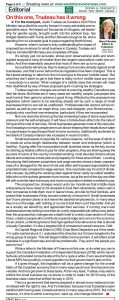 Saturday, September 9 ~ NATIONAL. BUSINESS EDITORIAL. On this one, Trudeau has it wrong.
Saturday, September 9 ~ NATIONAL. BUSINESS EDITORIAL. On this one, Trudeau has it wrong.
For the most part, Justin Trudeau as Canada’s 23rd Prime Minister has pulled this country forward in many admirable and respectable ways. He helped out thousands of refugees, set leadership for gender equity, brought youth into the political loop, has bridged relations with Trump and the USA well enough so far, and is standing firm on a broader goal to peace regarding North Korea.
However, when it comes to truly understanding the impact of proposed tax revisions for small business in Canada, Trudeau and finance minister Bill Morneau are completely off base.
It’s simply just not accurate, shows poor observational skills and short-sighted analysis to lump all smaller-than-the-largest corporations under one umbrella. And then essentially assume that most of them are up to no good.
Accountants will tell you they’re seeing more scrutiny already against small businesses, and that’s even before the tax legislation has been changed. This is the Liberal strategy to ‘take from the rich and give to the poor (middle class)’.
But what they don’t seem to get is that there is really no firm middle class any more — everybody is a worker. What vestiges of a middle class that remain will meet their deathknell by way of these proposed spirit-crushing tax strategies.
Trudeau says tax changes are aimed at ensuring wealthy Canadians pay their fair share. But these are in many cases not ‘wealthy’ people, just people who work hard at their game to achieve a good living. Affected by the proposed new legislation (which seems to be barreling ahead) will be such a range of small businesses that no one will be unaffected. Professionals like doctors will be impacted, as well as your car repair shop, your web designer, your fitness trainer… anybody who runs their own enterprise, particularly if they are incorporated.
Not only does this shrivel up the last remaining hopes of starry-eyed entrepreneurs and the self-employed, it will have a trickle-down effect into the rate of hiring and the cost of services. Small businesses generate most of the new jobs. And nowadays not many people are much above keeping their heads above water in a paycheque-to-paycheque/fixed-income economy, additionally burdened by two Bank of Canada interest-rate increases in recent months.
Small businesses incorporate for various reasons, not the least of which is to create an arms-length relationship between owner and enterprise (which is healthy). If going after the incorporated small business owner as the key source for shoring up federal coffers to pay for other programs, they are shaving away the success of some of the country’s hardest-working, most devoted citizens whose talents and enterprise create jobs and prosperity for those around them. Leveling the playing field between proprietors and wage earners shows a deep unawareness of or disregard for the level of risk and often self-imposed responsibility that proprietors take compared to wage-earners. One could also say it’s a bit of divide-and-conquer, by pitting the ‘working class’ against those ‘nasty’ so-called ‘wealthy’ folks who on the surface generate more income, but at the end of the day are often left with a similar take-home pay and more incorporation-related overhead to pay.
The proposed tax changes would undo tax incentives that middle-class entrepreneurs have relied on for decades to fund their retirements, retain cash in their companies to tide them over in leaner times, provide for their families, and protect their businesses if they choose maternity or become ill. Small businesses don’t have pension plans or sick leave like salaried employees do. In many ways they live on the edge, with nothing or no one to bail them out if they falter. And yet as a society we benefit by and appreciate their services. If running one’s own business becomes nothing more than an overly-responsible job without any perks, then the proposed tax changes are a death knell to a wide cross-section of industrious, creative people who contribute a special edge and verve to the economy. It’s an unkind, unthinking blow to that high-spirited innovative drive that is almost uniquely Canadian. It’s like a targeted kill of a treasured natural resource. Odd.
As Capital Regional District (CRD) Chair Barb Desjardins put it this week: “I’m quite worried about it. I understand the direction but it’s been targeted to the wrong group of people. This will target middle income earners. It will affect small business in a significant way and will be problematic. They aren’t the people you want to hurt.”
Write a letter to the Minister of Finance on this one, or do what you can to support the Canadian Federation of Independent Business (CFIB) which has effectively articulated concerns about this for a quite a while. Even several federal Liberal MPs have publicly voiced opposition to their government’s plan on this.
If it goes through, this legislation will be a game-changer for the overall fabric of the Canadian economy that in many ways would over time become irreversible. And let’s get down to brass tacks. At the very least, Trudeau may wish to rethink the small business tax revisions in order to retain for 2019 many of the business-class votes that shifted his way in 2015.
This is a government that seems prepared in almost every instance to barrel ahead with the right to rule. And it’s tolerated, because most Canadians seem satisfied with having seen Canada advance in many ways since 2015. But in this instance, it’s time to admit a wrong turn, back up, and change direction.
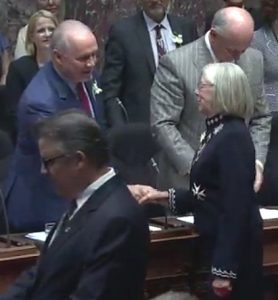
EDITORIAL INSIGHTS by WEST SHORE VOICE NEWS.
The tone of a Throne Speech as penned by an NDP government would of course sound different than that of the previous longstanding BC Liberal government. Listening to and supporting the people was espoused.
What was notably “21st century” for an NDP budget was a more definitive articulation of interrelationships with municipalities, industry, business and a wider range of population sectors.
The 30-minute address was delivered by Lt Gov Judith Guichon at 2pm on Friday September 8. Just a few months ago she had made the tough decision to pull the plug on the Christy Clark BC Liberals and give the NDP (with threeGreen Party MLAs in tow) a chance at leading British Columbia with a minority government.
To that point, the speech dropped something of a ‘bomb’ by announcing the next fixed election date as being in Fall 2021. That gives BC Premier John Horgan and his government a full four years to roll out their people-first policies and make them stick. Fixed-date elections would follow every four years.
The new government is also promising to deliver on Proportional Representation by setting the terms for a referendum by November 2018, in favour of reform “so that citizens can be sure that every vote counts”. Big money donations (corporate and union) will be eliminated and individual donors to political parties will have to be residents of BC.
Answering to one of the overriding NDP themes in the May 2017 election, came this: “Too many families were left behind for too long. It’s time that we made life more affordable.” Most families will be happy to hear that, but opponents will watch to see how that is accomplished with stability in the budget.
The government says it will consult with the public on various things ahead of delivering the first full budget in February 2018. Meanwhile, the Throne Speech purported some first steps toward making life more affordable such as helping renters by closing fixed term lease loopholes, and increasing support to the Residential Tenancy Branch toward fair treatment for both tenants and landlords.
A Fair Wages Commission will put BC on a path to a $15/hour minimum wage, by setting the course for stable and predictable increases over time.
Action is being taken to fix the problems at ICBC and BC Hydro, it was stated in the speech, to make sure that Crown corporations can deliver the “best possible service… at the lowest possible cost.”
A legislated poverty reduction plan will be brought in, with that work getting underway in the coming weeks.
Government says it will deliver a province-wide child care program, starting with the creation of more spaces and training more early childhood educators. Consultations with families and child care providers will be undertaken this fall.
Housing affordability was addressed with a statement about working with municipalities, cooperatives and the private sector to increase the supply of rental, social, co-op and owner-purchase homes.
The promise overall is for “relief from high costs and fees, better access to services, and an economy that works for everyone.”
Meanwhile, BC Green Party Leader Andrew Weaver said in a news release after the Throne Speech that he is “pleased to see so many BC Green ideas included in the new blueprint for government.” He continued: “This session, we will finally see corporate and union donations banned following the lead we took a year ago in banning them from our Party. We will see lobbying reform, a BC Green initiative, which will go even further towards ending the undue influence of special interests in our politics. BC will also have an Innovation Commissioner, one of the ideas in our emerging economy platform that will help ensure BC’s long term economic prosperity.” Weaver was encouraged by increased funding for public education as one of “the best investments government can make”.
The Greens are integral to maintaining a go-forward minority government. However, Weaver explained that the Green MLAs will not always agree with everything the government does. “As with any relationship, this disagreement is healthy. All three parties share many values and goals, though we might sometimes differ on the best ways to implement them. There is much we can accomplish together if we are willing to engage in thoughtful, productive debate and to consistently put the interests of our constituents first.”
Thursday, September 7 ~ BC. Things are gearing up for an active session at the BC Legislature under the new BC NDP government.
Lt Gov Judith Guichon will open the second session of the 41st Parliament of British Columbia on Friday, September 8. She will read the speech from the throne starting at 2 pm. The speech will be viewable live at www.leg.bc.ca
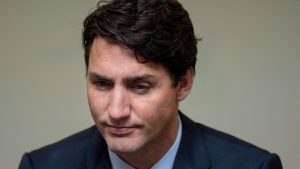
Sunday, September 3 ~ OTTAWA. North Korea announced this weekend that it had detonated its sixth and most powerful nuclear test yet, which it declared a “perfect success.”
Prime Minister Justin Trudeau issued the following statement in response to North Korea’s latest testing of a nuclear weapon:
“Canada unequivocally condemns North Korea’s nuclear test of September 3 which, combined with its aggressive program of ballistic missile testing, represents a clear and present threat to the safety and security of its neighbours and the international community.
“This most recent test, which appears to have been of a much greater magnitude than its five previous nuclear explosions, is in direct contravention of multiple UN Security Council resolutions, and demonstrates once again North Korea’s flagrant disregard of international law.
“These continued provocations by North Korea’s leadership, along with their profoundly dangerous push to develop nuclear weapons and test ballistic missiles near neighbouring countries, only serve to further isolate them.
“Canada has been steadfast in insisting that North Korea abandon its current course, including its aggressive rhetoric, and asks that it resumes constructive dialogue toward a comprehensive and verifiable solution.
“We urge the UN Security Council to take further decisive action to effectively constrain North Korea’s proliferation efforts, and call on all states to fully implement relevant UN sanctions.
“We will continue to work with key regional partners – including the United States, South Korea and Japan – as well as the broader international community, to counter the North Korean threat.”
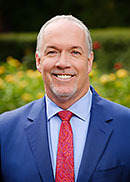
Sunday, September 3 ~ VICTORIA. Statement from Premier John Horgan for Labour Day (September 4):
“On Labour Day we recognize the hard-working people of British Columbia, who built this province from the ground up.
“Labour Day is a day of rest, and an opportunity to reflect on the progress made by working people. The hard-fought victories of the labour movement over generations made life better for everyone.
“People who work hard deserve a government that works hard for them. Our government will increase the minimum wage, open the doors to apprenticeships and skills training, strengthen employment standards and create safer workplaces for all. Because building up our province starts by building up our people.
“I join you in celebrating this special day.”
On Monday, September 4, Premier John Horgan and Minister of Labour Harry Bains will be joining others, including Patty Hajdu, federal Minister of Employment, Workforce Development and Labour, in an annual Labour Day celebration with the New Westminster and District Labour Council. Starting at 11:30 am in Holland Park, 13428 Old Yale Road, Surrey.
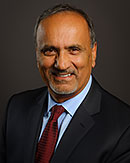
Saturday, September 2 ~ OPINION-EDITORIAL. At the crux of this Labour Day: ensuring worker safety. By Harry Bains, BC Minister of Labour.
Many forget that Labour Day is much more than an opportunity for backyard barbecues, community picnics and for some, a day off work. However, the true purpose of the holiday is a celebration of the achievements and progress of the working class.
Communities, big and small, urban or rural, depend on business and industry, not just for maintaining jobs and the tax base, but because they help define the culture and spirit of the place we call home. They rely on the bakeries, the unique gift shop, the local mechanic’s garage and community grocer that sponsor the little league team; and the large employers, the chains and franchises that invest in our cities and employ our families and neighbours. We owe much to these employers, but Labour Day is about what is also owed to the workers.
Throughout my career as a trade unionist, I have known one thing: workers want fairness. They want a level playing field for all workers. I have devoted my time to helping people gain a voice when discriminated against, when treated unfairly by the employer, when rights and freedoms are not respected. However, the biggest impact on me personally, professionally and politically was helping families find their voice after tragedy. I have stood beside loved ones mourning the loss of a family member, a husband or wife that they kissed goodbye in the morning for a day filled with promise, who never to return home because the promise of a safe workplace was broken.
Workers deserve and should demand safe working conditions. The legacy I hope to leave as the new Minister of Labour and first NDP Labour Minister in more than 16 years is to make British Columbia the safest jurisdiction in Canada for workers. We have come a long way, but more can be done and must be done!
Whether it’s ensuring safety for workers, giving workers a long overdue raise by increasing the minimum wage, or bringing back the Human Rights Commission dismantled by our predecessors, you can trust that your BC government is fighting for families on real issues, like affordability, good paying jobs and improved public services, as well as an economy that works for and is inclusive of everyone. Central to our promises this Labour Day is also our pledge to do everything we can to help reduce preventable work accidents, enforce regulations and support workers in their journey to get back to work.
On this Labour Day, join me in celebrating all that workers have done to make life better for themselves and their families.
Back to the BC/NATIONAL Current Breaking News page | Back to Main page of the WSV website

